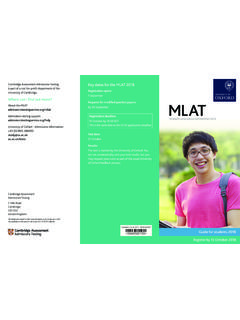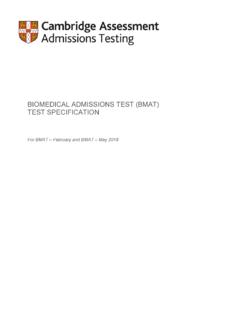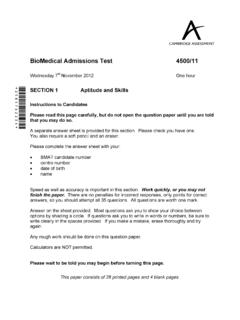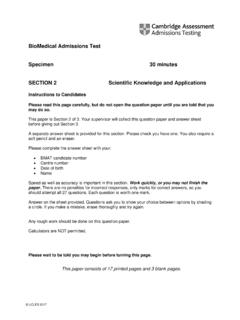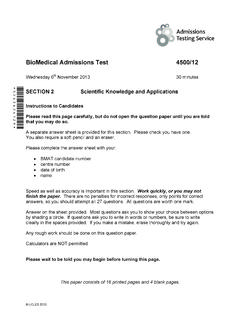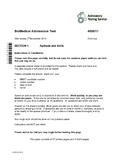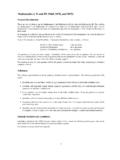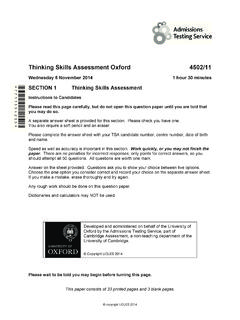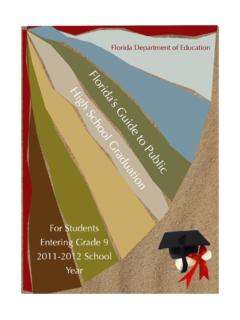Transcription of Test of Mathematics for University Admission Notes on …
1 Test of Mathematics for University Admission Notes on Logic and Proof November 2021. UCLES 2021. Notes for Paper 2 of The Test of Mathematics for University Admission You should check the website regularly for updates to these Notes . Introduction The formal side of Mathematics that of theorems and proofs is a major part of the subject and is the main focus of Paper 2. These Notes are intended to be a brief introduction to the ideas involved, for the benefit of candidates who have not yet met them within their Mathematics classes or within their wider mathematical reading. Mathematics , in part, is about working out the relationships between (mathematical) statements.
2 And it is very important that everyone (that is, all mathematicians) write and talk about these relationships in the same standard way. It is important because Mathematics is expressed formally using a rigorous language and if different people mean different things when they use the same words, then it would be difficult to ensure that everyone is talking about (and agreeing about) the very same things. Learning the basics of the rules and terms used by mathematicians is essential if you are to be able to understand and contribute to Mathematics . These Notes are written to help introduce you to some of the terms used regularly by mathematicians specifically the terms we have included in Section 2 of the specification.
3 Before you launch into reading through what we have written, there are a few things to keep in mind: 1. This guide is designed to be a brief overview. It is not designed to be an extensive textbook, but it should be enough to allow you to get a good understanding of the topics in Section 2 of the specification. It should also be sufficient to enable you to understand and tackle the questions we will ask in the Admission test. 2. As you read through the guide, make sure you take the time to think through everything very carefully. Many of the ideas set out here are quite subtle and take some time to grasp, so skimming through everything is certainly not enough to ensure you have a good understanding.
4 Rather, you should play around with the ideas as you meet them, and try to come up with your own examples. In other words, read through things actively with a pencil and paper to hand; think carefully about everything, draw your own pictures, write out your own examples, and so on. 3. Another thing you should do is to try to read more widely on the topics set out here. The internet has some good explanations and examples of the ideas we outline and there are some good books available from libraries that might also help. UCLES 2021. 4. A good way to test if you have understood something is to see if you would be able to explain the ideas to a friend or a class of students.
5 If you get a chance, it is always useful to study the ideas and talk about them with other people again, maybe with others in your maths classes or with your maths teacher. 5. As you work through this enhanced specification, make sure you are aware that the language used by mathematicians has very precise meanings and these do not always coincide with the way words are used in everyday casual contexts. For instance, if I am told that I may have jelly or cake for pudding, I would probably assume it meant I could have jelly or cake but not both. However, in Mathematics , or' means one, or the other, or both', so if I were being offered pudding by a mathematician then I could have both jelly and cake if I wanted.
6 6. Throughout, we have tried to explain the ideas in at least two different ways: one using the formal notion of truth tables and one using a more intuitive diagrammatic approach. It is worth making sure you understand both approaches and how they relate to each other. 7. Finally, a small note of caution: in this specification we have tried to take a simple and slightly na ve view of the ideas we are trying to explain rather than one that sets out all the deep subtleties that abound in Mathematics and the philosophy of logic/ Mathematics . We have been as rigorous as necessary to achieve our aims, but you should not take what we have written as the perfect and final word on things and we have deliberately avoided some issues as they would only complicate matters unnecessarily.
7 For instance, some mathematicians or philosophers might take issue with our examples of statements or our notion of truth and so on. For what we aim to achieve these issues are not relevant, but that is not to say they aren't interesting. UCLES 2021. The relevant part of the specification SECTION 2. This section sets out the scope of Paper 2. Paper 2 tests the candidate's ability to think mathematically: the paper will focus on testing the candidate's ability to understand, and construct, mathematical arguments in a variety of contexts. It will draw on the mathematical knowledge outlined in SECTION 1 in the test specification. The Logic of Arguments Arg1 Understand and be able to use mathematical logic in simple situations: The terms true and false.
8 The terms and, or (meaning inclusive or), not;. Statements of the form: if A then B. A if B. A only if B. A if and only if B. The converse of a statement;. The contrapositive of a statement;. The relationship between the truth of a statement and its converse and its contrapositive. Note: candidates will not be expected to recognise or use symbolic notation for any of these terms, nor will they be expected to complete formal truth tables. Arg2 Understand and use the terms necessary and sufficient. Arg3 Understand and use the terms for all, for some (meaning for at least one), and there exists. Arg4 Be able to negate statements that use any of the above terms.
9 Mathematical Proof Prf1 Follow a proof of the following types, and in simple cases know how to construct such a proof: Direct deductive proof ( Since A, therefore B, therefore C, , therefore Z, which is what we wanted to prove.');. Proof by cases (for example, by considering even and odd cases separately);. Proof by contradiction;. Disproof by counterexample. Prf2 Deduce implications from given statements. Prf3 Make conjectures based on small cases, and then justify these conjectures. UCLES 2021. Prf4 Rearrange a sequence of statements into the correct order to give a proof for a statement. Prf5 Problems requiring a sophisticated chain of reasoning to solve.
10 Identifying Errors in Proofs Err1 Identifying errors in purported proofs. Err2 Be aware of common mathematical errors in purported proofs; for example, claiming if = , then = ' or assuming if sin = sin , then = '. neither of which are valid deductions. UCLES 2021. MATHEMATICAL LOGIC. Statements The Logic of Arguments Arg1: The terms true and false At the heart of Mathematics , and mathematical logic, is the notion of a statement and the relationship between statements. But what can we say about the statements we shall meet in Mathematics ? We can say that they must be either true or false, but not both. And it does not matter if we cannot actually work out whether a statement is actually true or false so long as it must be one or the other.
